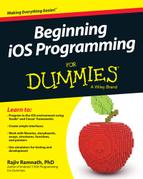Book Description
The ultimate beginner's guide to programming in the iOS environment
The Apple App Store is a gold mine for developers, but with more apps for the iPhone, iPad, and iPod touch being added every day, it s essential to have a solid programming foundation to create the best apps possible. If you're eager to learn the ins and outs of iOS programming, this is your book. It teaches object-oriented programming within the iOS framework from the ground up, preparing you to create the next super iPhone or iPad app.
Get a handle on the iOS framework, object-oriented best practices, and the Xcode programming environment, then discover how to create simple interfaces, use libraries, create and extend objects, and more. Whether you're just starting out in programming or only new to iOS, For Dummies is the perfect beginning.
Focuses on teaching object-oriented programming within the iOS framework and includes best practices for building apps that are easy to debug, evolve, and maintain
Uses simple examples to demonstrate object-oriented programming output in the iPhone environment while teaching real-world programming concepts and applications
Provides a thorough understanding of the framework and object-oriented principles to help beginning programmers make optimum use of iOS
Covers working with the Xcode environment and storyboards; creating simple interfaces; using libraries, functions, structures, arrays, and pointers; and creating and extending objects
Beginning iOS Programming For Dummies is your straightforward guide to getting started with iOS programming.
Table of Contents
- Introduction
- Introduction
- Part I: Getting Started with iOS Programming
- Chapter 1: Entering Mobile Application Development
- Chapter 2: Object-Oriented Design Principles
- Chapter 3: Effectively Using Objective-C
- Part II: Meeting the Methods and Platforms
- Chapter 4: Patterns and Frameworks
- Chapter 5: Setting Up to Develop iOS Apps
- Chapter 6: Developing an App on iOS
- Chapter 7: Illustrating Object-Oriented iOS App Design
- Customizing an SDLC for iOS App Development
- Developing Use Cases
- Creating the User Interface
- Illustrating Object-Oriented Design
- Collaborators and missing classes and responsibilities
- Contracts and signatures
- Implementing an Object-Oriented Design on iOS
- Analyzing the OO and Design Principles Used in Tic-Tac-Toe
- Part III: Making Your iOS Apps Fit for Consumption
- Chapter 8: Effectively Using Xcode
- Chapter 9: Developing Your App’s User Interface
- Chapter 10: Making Applications Fast and Responsive
- Chapter 11: Making Your App Reliable and Secure
- Part IV: Connecting Your Apps
- Chapter 12: Channeling the World Into Your Device
- Chapter 13: Harnessing iOS Device Capabilities
- Chapter 14: Publishing to the App Store
- Part V: The Part of Tens
- Chapter 15: Ten Resources for Object-Oriented Development
- Chapter 16: Ten Developer Resources for iOS
- About the Author
- Cheat Sheet
- More Dummies Products
